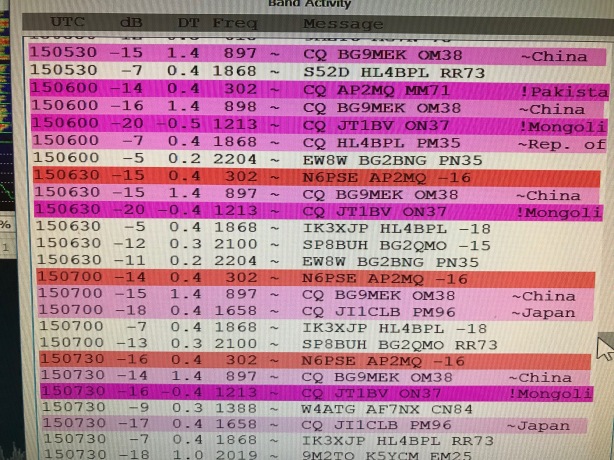
FT8 has been a really fun new mode for me. One of the many aspects that I enjoy about FT8 is that it seems to work really well with very little propagation or otherwise poor conditions.
This past week, there has been a “pipeline” of propagation to India just about an hour after our sunrise, on 20 meters. I would not expect this in late June. This morning, I had a lot of fun as both AP2MQ and JT1BV were calling CQ via FT8.
FT8 is the “great equalizer”. It seems to level the playing field where big or small stations can all participate and make the contacts. Some naysayers will scoff and say that the computer does all the work but I don’t agree with that. You need to “chase” the difficult/hard to work stations on FT8 just as you would with CW/SSB. You need to understand and follow the propagation. You need to have your station configured perfectly to complete the contact. You need to understand “split operation” in FT8 and how to listen off frequency from the DX. If you fail in any one of these areas, you won’t make the contact.
And FT8 is not immune to the other problems that plague SSB/CW. There are many out of turn callers who continue to call the DX even though he is replying to you. As it was this morning, I was not able to complete my QSO with AP2MQ even though he replied to me 7-8 times with a signal report as others moved onto his frequency to call him. There are continuous callers who just seem to call a station over and over even as he is replying to and working others. And what seems more unique to FT8 callers is when you are calling a rare DX station and then 4-5 guys start calling you on the frequency you are telling the rare DX station that you are listening on.
Even with these issues, FT8 is still a very fun and productive mode.
What do you think?
Very well written! Welcome to the hooked!
You might find this intersting: https://www.ft8dmc.eu/FEEDBACK
73 and good DX in ALL modes
Hannes, OE1SGU
Hello Hannes-OE1SGU, yes, you can consider me “hooked” on FT8. It has given me a lot of fun! Thank you for visiting my Blog. Best 73, Paul N6PSE
I think FT8 is becoming a victim of its own success. Often times there are too many stations active in the narrow window, and many of them don’t seem to understand how the process works, which can spoil everyone’s fun. As more and more stations come online, the window will have to grow wider, I think. But that will diminish some of the attractiveness of the mode in the first place — one of the nicer things about FT8 is that you can basically see all the band activity in one place.
I’m apprehensive about the KH1 DXpedition’s use of the special “DXpedition mode.” The few times I’ve seen it live on the air, everyone seemed a bit confused by it. It would have been better, I think, to soft launch it on some smaller DXpeditions so the eager masses had a better handle on it before taking it to a Top 5. Still, if things don’t get too crazy, I’ll be in there calling with everyone else.
Hi Mike, I completely agree about FT8 becoming a victim of it’s own success. I want to yell “Spread Out!” as everyone bunches up on 20 meters. 30 meters has been very productive for me and the rate is better as there is less congestion.
I think the KH1 FT8 approach will work well for us in W6. As Rich writes, we are an easy “chip shot”. I would be quite concerned if I was in Europe as they will need all the yelp they can get to get each and every contact. Let’s hope for decent propagation!
Best 73,
Paul N6PSE
There are a couple of features with FT8 that are important to consider when operating. The first is that FT8 is ideal for split-mode contacts. It is so good that split-mode should generally be the default mode. It reminds me of my rockbound novice days, but the program will search out the stations transmitting to my call sign, so I don’t even have to turn the dial.
When a station sends RR73, if you are operating split, your call is likely to be decoded avoiding the extra 30 seconds for him to send CQ. If you, and everyone else are using his transmit frequency, successful decode is much less likely.
The other feature is a problem which is made much worse by the time locked transmission protocol used by FT8 and other similar modes. That is, you have no idea whether someone else is transmitting on top of you. With CW, you have full break in and with the voice modes, it is likely you will stop transmitting while he is still transmitting, so you can notice him.
With FT8, you need to stop transmitting and look at your waterfall. Sometimes just stopping for 1 or 2 seconds is enough, and your intended recipient may still be able to decode your transmission, but sitting out a round is sometimes necessary.
I was having fun calling CQ from New Hampshire with 5 watts and getting many European stations to respond. I even worked some ATNOs this way. However, I had to frequently change my frequency to avoid other stations who were transmitting on the same frequency. It turned out that if I wasn’t getting responses to my CQs, it was almost always because I was being stepped on, that was a clue that I should check.
73 Bill AE6JV
Bill, these are all very useful tips, particularly operating split which I do most of the time. Thanks for sharing them with the readers of this Blog.
Best 73,
Paul N6PSE